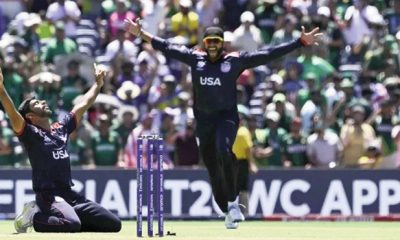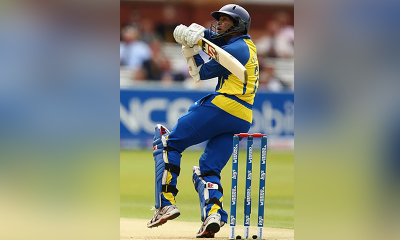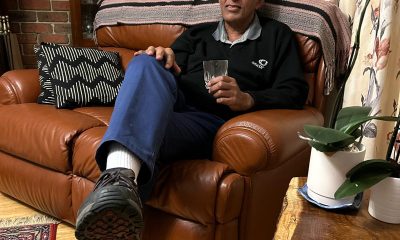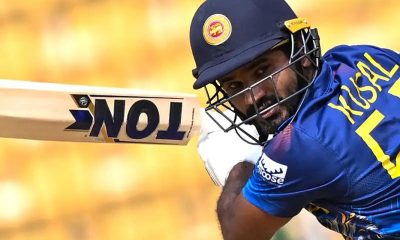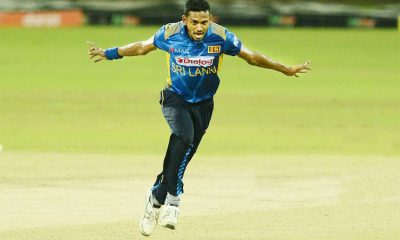Features
Clive Inman recalls cricketing life in 2020 interview

Clive Clay Inman (born January 29, 1936 in Colombo died on December 7, 2022 in England). He was a former Ceylon cricketer, represented NCC in domestic Club Cricket and later played English County Cricket representing Leicestershire and Derbyshire. He captained his alma mater, St Peter’s College, Colombo 04 in 1954 and 1955 and won the Battle of the Saints Big match against St. Joseph’s College Colombo in 1955.
He comes from a family of cricketers. His father, Harry Inman, played for Ceylon teams as an allrounder. Clive had four brothers, all cricketers, of whom Roger played and captained S. Thomas’ College in 1952 (Clive played against him for St. Peter’s). Clive was a prolific left-hand batsman and also a right arm off break bowler who excelled during his school career, and later on, built a name for himself as an outstanding batsman for Ceylon and English County Leicestershire during the 60’s.
Call it a scoop, call it an exclusive interview, call it whatever you wish, but to this writer it was a scoop, a rare opportunity grabbed with both hands by Sujith Silva (Editor in Chief of Quadrangle), Brian Lawrence (also of Quadrangle) and myself (Algi Wijewickrema). The personality that Sujith, Brian and I had the extremely rare privilege of having this telephone interview was Clive Clay Inman, a much talked of cricketer in the 1950s and 60s.
Now in his 84th year, Clive — who represented Leicestershire from 1963 to 1971 as one of their top middle order batsmen– continues to live in England and we were able to contact him thanks to the modern day communication tools.
Born in 1936 to Harry and Edith Inman, Clive lived with his parents and siblings in Wellawatte. At the time he was to be admitted to school (possibly in 1941, he could not recall the exact year), he was expected to enter S. Thomas’ College (STC), Mt. Lavinia like his brothers, Earnest, Trevor and Roger. But fate decreed otherwise.
Said Clive, “The entrance exam at S. Thomas’ was a lengthy, two part ordeal commencing in the morning and running into the second session after a break for lunch; but by lunch time I had decided not to continue.” He had decided to join St. Peter’s despite his father’s desire to have him enrolled at STC. When his father had found out from the Thomian headmaster that he had not stayed for the entire exam, he had come home and asked Clive why. And Clive had told him that he wanted to join St. Peter’s College. “Father and mother then had a chat and father gave his consent and I joined St. Peter’s.”
Let me quote Clive on what he thought of his decision to join St. Peter’s, “I enjoyed being at St. Peter’s from the time I was admitted. The Rector then was Rev. Fr. Basil Wiratunga, who was a great man. I had no regrets whatsoever as I was looked after well”.
Clive’s cricket at St. Peter’s had begun at the age of 15 in 1950 as a left-handed batsman. He said: “I played as a batsman though I may have bowled a little, but I always preferred batting to bowling.” He continued “We had Herbert Wittachchi as our team coach, but my personal coach was Cyril Ekanayake. He (Cyril) had not been a cricketer of any standing but was an excellent coach and in my opinion no one could match him. He could not bowl but shied the ball from halfway down the wicket, getting me to hit it, 10 minutes of the forward defence and 10 minutes of backfoot defence and so on”.
With all three of his brothers playing cricket for STC, interestingly his brother Roger – the only one to captain STC – had captained STC in 1952 the year Clive played for St. Peter’s under H I K Fernando. Although the brothers were Thomian cricketers and he the only Peterite in the family, there had not been any arguments at home. Clive recalled “When I first played for St. Peter’s, my mother told Roger that if he was bowling when I came in to bat, he should allow me to get off the mark and Roger protested saying he couldn’t do that. But mother insisted saying he’d have her to answer to, if that did not happen. And that was the end of discussion”.
Recounted Clive “My mother was my greatest fan and never missed a match I played in. My father also attended matches that I played in but not all and was late for some. Once he came late for a match when I was batting and not long after he arrived I got out. At home that night my mother insisted that he either arrives for the match before the start or not show himself till I had got out; and that is exactly how it was with my father and his attendance at Peterite matches”.
Although his record score of 204 retired hurt in the Big Match (Joe-Pete) was when he first captained in 1954, he said “My most memorable match was the Josephian-Peterite encounter in 1955 which we won at the Colombo Oval that was packed with spectators on both days.” In that match the Joes had batted first and had been bowled out for a paltry 117 and the Petetites had rattled up 224 in the first inning. In their second inning the Joes had done better scoring 150 leaving the Petes 44 to win, which they had scored for the loss of 2 wickets (46/2).
This, no doubt, was memorable not only for Clive, but for all Peterites as it was a win earned after seven years but more importantly it was only their third win after the two consecutive victories under Dion Walles in 1946 and 1947.
Comparing the two Big Matches of 1954 and 1955 under his captaincy, Clive’s attitude was “Whether I scored a century or zero, what was important for me was whether we won or not.”
He recalled how he was detained once for talking in class and when in the detention class after school who walks in but Cyril Ekanayake. Upon learning from Clive why he was talking in class – which had been a discussion with Ken Duckworth about the next match – he had been allowed to go home.
Asked to recall some of the teammates who have stayed in his memory he recalled Luckshman Serasinghe, Kenneth and Russel Duckworth, Brian Seneviratne (wicket keeper), Brian and Maurice de Silva and Ranjith Jayasinghe. He singled out H I K Fernando as a top-notch wicket keeper and a great batsman. The only non-Peterite cricketer he could recall was ACM Lafir of St. Anthony’s College, Katugastota.
Apart from the two coaches, Herbert Wittachchi and Cyril Ekanayake, he remembered Rev. Fr. Rodrigo (he couldn’t recall the first name), who had been the Prefect of Games then and the groundsman Nomis. About Nomis he even recalled: “Nomis would say “Wish I could swim better” because I used to frequently hit the ball into the canal and he had to retrieve them.”
Speaking about the Rector, Fr. Basil Wiratunga, he reminisced “In 1955 before the Big Match Fr. Rector asked me what I wanted if St. Peter’s is to win. I told him we needed bats, gloves and pads for the players. I also requested that the cricketers should be excused from afternoon classes. He said “done”.
“Even Masters at College used to tell me that I had more influence over the Rector than anyone else. He backed me all the way and at no other school could this have been done. The Big Match win that year was as much a celebration for Fr. Rector as it was for me since it was the last Big Match for both of us”.
When Clive ended his cricketing career at St. Peter’s spanning five years (1951-1955) he had scored one double century, five centuries and 17 fifties and as captain in 1954 and 1955, earned four wins against one loss.
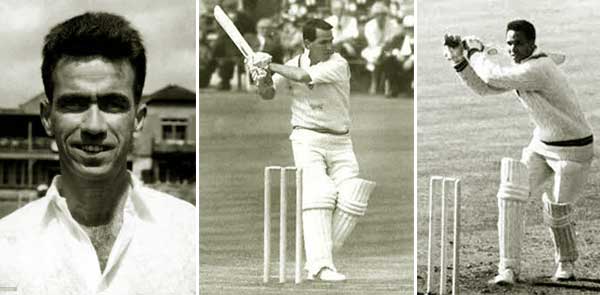
After leaving College, Clive had joined Colts Cricket Club as his uncle was there, but later in 1956 had moved to NCC for three reasons (1) he admired the then NCC Captain, (2) H I K Fernando his former Peterite captain playing for NCC at the time and (3) his friend Stanley Jayasinghe being in the NCC team.
Making his first-class debut in 1956, representing Ceylon against India at the Colombo Oval he had not been able to make an impression, but said that throughout his career he was happy batting and could not recall bowling at any match. However, records show that he has bowled in this match and a few other matches.
Clive represented Ceylon in the Gopalan Trophy matches against Madras, which was the only regular first class international cricket Ceylon had before gaining test status. Though Clive’s appearances for Ceylon were not regular he did represent Ceylon in 1956-57 and 1958-59 in the Gopalan Trophy and against the touring MCC in 1961-62. He toured Pakistan in 1966-67.
Speaking of being selected to play for Ceylon and not playing Clive reminisced “On one occasion Stanley Jayasinghe had written an article to a newspaper critical of the Board of Control for Cricket in Ceylon or against the South Africans and apartheid and had been omitted from the team to represent Ceylon. I was in England, but had been selected and received my contract.
“On going through the contract I found that Sanley’s name was not there. I called uncle Sara and asked him about it and said I would not come. He said “don’t be a fool” but I stood firm and told him Stanley is the best batsman in Ceylon and should be in the team. So, I refused to play for Ceylon on that occasion.”
Once he had moved to England and joined his friend from Ceylon, Stanley Jayasinghe, in his first appearance for Leicestershire in 1961, Clive had played against the touring Australian side contributing 30 and 45 not out. However, he had represented Leicestershire in the County Championships for the first time only in 1963 after completing the mandatory two-year residential qualification period. His maiden first class century for the county had been in his first county championship year in 1963 against the University of Cambridge.
Asked to comment about his Guinness Record of 50 runs in eight minutes for Leicestershire, Clive said the record lost its glow when in the next match he got a 50 and helped Leicester to win. But recalling that match, he said he regretted he was not able to hit a six to land in the river beyond the boundary and the fact that Stanley Jayasinghe (another Sri Lankan cricketer of repute), also playing for Leicestershire, being run out for 99 in that match.
Of playing against famous international teams Clive said that he had played against West Indies, Australia, India and Pakistan when they played against his County, Leicestershire. Continuing to speak of cricket against international teams and the bowling he had faced, Clive said “Wes Hall, Charlie Griffith of the West Indies and Dennis Lillee of Australia are some of the overseas cricketers I have batted against.
“Also while playing county cricket, I have played against some of the great English bowlers such as Fred Trueman, Brain Statham and Frank Tyson. The greatest all rounder for me is Sir Garfield Sobers”. Asked to comment on how he played such great bowlers of his time he said “I just played each ball on its merits”.
I couldn’t resist asking him if he would be able to visit St. Peter’s for its centenary celebrations in 2022, but with regrets in his voice he said “No, my traveling days finished 10–12 years ago when I broke both my ankles. I can walk now but with great difficulty and not long distances. But give my best regards to all at St. Peter’s College”.
Of his family, his wife Josephine has passed away 14 years ago and apart from a son who died when he was small, he had lost another son a few years ago and the only surviving son, Andrew, lives in Australia.Asked to comment about good Sri Lankan cricketers in Sri Lanka (current and recent), Clive picked Kumar Sangakkara and Mahela Jayawardena as exceptional cricketers.
Coming towards the end of our telephone interview Clive said “I refused to be involved with English cricket and always wanted to play for Ceylon (now Sri Lanka), which I still call home and moreover, I ask what could I have done if I was selected to play for England and England was playing against Ceylon”.
Asked for any advice for young cricketers his advice was “You can’t play without practice. So, practice, practice and practice for that is how you can improve”.
On that note of good advice from a brilliant cricketer of yesteryear, we concluded “The Scoop”.
Our sincere appreciation to Old Peterite Mr. Brian Ratnayake (England) for his efforts to get us in touch with Clive Inman and Mr. Andrew Inman (Australia) son of Clive Inman for sharing valuable images of his father. ……. Image credits; courtesy of Leicestershire County Cricket Club, Stanley Jayasinghe and Andrew Inman. (www.quadrangle.lk)
Features
The heart-friendly health minister

by Dr Gotabhya Ranasinghe
Senior Consultant Cardiologist
National Hospital Sri Lanka
When we sought a meeting with Hon Dr. Ramesh Pathirana, Minister of Health, he graciously cleared his busy schedule to accommodate us. Renowned for his attentive listening and deep understanding, Minister Pathirana is dedicated to advancing the health sector. His openness and transparency exemplify the qualities of an exemplary politician and minister.
Dr. Palitha Mahipala, the current Health Secretary, demonstrates both commendable enthusiasm and unwavering support. This combination of attributes makes him a highly compatible colleague for the esteemed Minister of Health.
Our discussion centered on a project that has been in the works for the past 30 years, one that no other minister had managed to advance.
Minister Pathirana, however, recognized the project’s significance and its potential to revolutionize care for heart patients.
The project involves the construction of a state-of-the-art facility at the premises of the National Hospital Colombo. The project’s location within the premises of the National Hospital underscores its importance and relevance to the healthcare infrastructure of the nation.
This facility will include a cardiology building and a tertiary care center, equipped with the latest technology to handle and treat all types of heart-related conditions and surgeries.
Securing funding was a major milestone for this initiative. Minister Pathirana successfully obtained approval for a $40 billion loan from the Asian Development Bank. With the funding in place, the foundation stone is scheduled to be laid in September this year, and construction will begin in January 2025.
This project guarantees a consistent and uninterrupted supply of stents and related medications for heart patients. As a result, patients will have timely access to essential medical supplies during their treatment and recovery. By securing these critical resources, the project aims to enhance patient outcomes, minimize treatment delays, and maintain the highest standards of cardiac care.
Upon its fruition, this monumental building will serve as a beacon of hope and healing, symbolizing the unwavering dedication to improving patient outcomes and fostering a healthier society.We anticipate a future marked by significant progress and positive outcomes in Sri Lanka’s cardiovascular treatment landscape within the foreseeable timeframe.
Features
A LOVING TRIBUTE TO JESUIT FR. ALOYSIUS PIERIS ON HIS 90th BIRTHDAY

by Fr. Emmanuel Fernando, OMI
Jesuit Fr. Aloysius Pieris (affectionately called Fr. Aloy) celebrated his 90th birthday on April 9, 2024 and I, as the editor of our Oblate Journal, THE MISSIONARY OBLATE had gone to press by that time. Immediately I decided to publish an article, appreciating the untiring selfless services he continues to offer for inter-Faith dialogue, the renewal of the Catholic Church, his concern for the poor and the suffering Sri Lankan masses and to me, the present writer.
It was in 1988, when I was appointed Director of the Oblate Scholastics at Ampitiya by the then Oblate Provincial Fr. Anselm Silva, that I came to know Fr. Aloy more closely. Knowing well his expertise in matters spiritual, theological, Indological and pastoral, and with the collaborative spirit of my companion-formators, our Oblate Scholastics were sent to Tulana, the Research and Encounter Centre, Kelaniya, of which he is the Founder-Director, for ‘exposure-programmes’ on matters spiritual, biblical, theological and pastoral. Some of these dimensions according to my view and that of my companion-formators, were not available at the National Seminary, Ampitiya.
Ever since that time, our Oblate formators/ accompaniers at the Oblate Scholasticate, Ampitiya , have continued to send our Oblate Scholastics to Tulana Centre for deepening their insights and convictions regarding matters needed to serve the people in today’s context. Fr. Aloy also had tried very enthusiastically with the Oblate team headed by Frs. Oswald Firth and Clement Waidyasekara to begin a Theologate, directed by the Religious Congregations in Sri Lanka, for the contextual formation/ accompaniment of their members. It should very well be a desired goal of the Leaders / Provincials of the Religious Congregations.
Besides being a formator/accompanier at the Oblate Scholasticate, I was entrusted also with the task of editing and publishing our Oblate journal, ‘The Missionary Oblate’. To maintain the quality of the journal I continue to depend on Fr. Aloy for his thought-provoking and stimulating articles on Biblical Spirituality, Biblical Theology and Ecclesiology. I am very grateful to him for his generous assistance. Of late, his writings on renewal of the Church, initiated by Pope St. John XX111 and continued by Pope Francis through the Synodal path, published in our Oblate journal, enable our readers to focus their attention also on the needed renewal in the Catholic Church in Sri Lanka. Fr. Aloy appreciated very much the Synodal path adopted by the Jesuit Pope Francis for the renewal of the Church, rooted very much on prayerful discernment. In my Religious and presbyteral life, Fr.Aloy continues to be my spiritual animator / guide and ongoing formator / acccompanier.
Fr. Aloysius Pieris, BA Hons (Lond), LPh (SHC, India), STL (PFT, Naples), PhD (SLU/VC), ThD (Tilburg), D.Ltt (KU), has been one of the eminent Asian theologians well recognized internationally and one who has lectured and held visiting chairs in many universities both in the West and in the East. Many members of Religious Congregations from Asian countries have benefited from his lectures and guidance in the East Asian Pastoral Institute (EAPI) in Manila, Philippines. He had been a Theologian consulted by the Federation of Asian Bishops’ Conferences for many years. During his professorship at the Gregorian University in Rome, he was called to be a member of a special group of advisers on other religions consulted by Pope Paul VI.
Fr. Aloy is the author of more than 30 books and well over 500 Research Papers. Some of his books and articles have been translated and published in several countries. Among those books, one can find the following: 1) The Genesis of an Asian Theology of Liberation (An Autobiographical Excursus on the Art of Theologising in Asia, 2) An Asian Theology of Liberation, 3) Providential Timeliness of Vatican 11 (a long-overdue halt to a scandalous millennium, 4) Give Vatican 11 a chance, 5) Leadership in the Church, 6) Relishing our faith in working for justice (Themes for study and discussion), 7) A Message meant mainly, not exclusively for Jesuits (Background information necessary for helping Francis renew the Church), 8) Lent in Lanka (Reflections and Resolutions, 9) Love meets wisdom (A Christian Experience of Buddhism, 10) Fire and Water 11) God’s Reign for God’s poor, 12) Our Unhiddden Agenda (How we Jesuits work, pray and form our men). He is also the Editor of two journals, Vagdevi, Journal of Religious Reflection and Dialogue, New Series.
Fr. Aloy has a BA in Pali and Sanskrit from the University of London and a Ph.D in Buddhist Philosophy from the University of Sri Lankan, Vidyodaya Campus. On Nov. 23, 2019, he was awarded the prestigious honorary Doctorate of Literature (D.Litt) by the Chancellor of the University of Kelaniya, the Most Venerable Welamitiyawe Dharmakirthi Sri Kusala Dhamma Thera.
Fr. Aloy continues to be a promoter of Gospel values and virtues. Justice as a constitutive dimension of love and social concern for the downtrodden masses are very much noted in his life and work. He had very much appreciated the commitment of the late Fr. Joseph (Joe) Fernando, the National Director of the Social and Economic Centre (SEDEC) for the poor.
In Sri Lanka, a few religious Congregations – the Good Shepherd Sisters, the Christian Brothers, the Marist Brothers and the Oblates – have invited him to animate their members especially during their Provincial Congresses, Chapters and International Conferences. The mainline Christian Churches also have sought his advice and followed his seminars. I, for one, regret very much, that the Sri Lankan authorities of the Catholic Church –today’s Hierarchy—- have not sought Fr.
Aloy’s expertise for the renewal of the Catholic Church in Sri Lanka and thus have not benefited from the immense store of wisdom and insight that he can offer to our local Church while the Sri Lankan bishops who governed the Catholic church in the immediate aftermath of the Second Vatican Council (Edmund Fernando OMI, Anthony de Saram, Leo Nanayakkara OSB, Frank Marcus Fernando, Paul Perera,) visited him and consulted him on many matters. Among the Tamil Bishops, Bishop Rayappu Joseph was keeping close contact with him and Bishop J. Deogupillai hosted him and his team visiting him after the horrible Black July massacre of Tamils.
Features
A fairy tale, success or debacle

Sri Lanka-Singapore Free Trade Agreement
By Gomi Senadhira
senadhiragomi@gmail.com
“You might tell fairy tales, but the progress of a country cannot be achieved through such narratives. A country cannot be developed by making false promises. The country moved backward because of the electoral promises made by political parties throughout time. We have witnessed that the ultimate result of this is the country becoming bankrupt. Unfortunately, many segments of the population have not come to realize this yet.” – President Ranil Wickremesinghe, 2024 Budget speech
Any Sri Lankan would agree with the above words of President Wickremesinghe on the false promises our politicians and officials make and the fairy tales they narrate which bankrupted this country. So, to understand this, let’s look at one such fairy tale with lots of false promises; Ranil Wickremesinghe’s greatest achievement in the area of international trade and investment promotion during the Yahapalana period, Sri Lanka-Singapore Free Trade Agreement (SLSFTA).
It is appropriate and timely to do it now as Finance Minister Wickremesinghe has just presented to parliament a bill on the National Policy on Economic Transformation which includes the establishment of an Office for International Trade and the Sri Lanka Institute of Economics and International Trade.
Was SLSFTA a “Cleverly negotiated Free Trade Agreement” as stated by the (former) Minister of Development Strategies and International Trade Malik Samarawickrama during the Parliamentary Debate on the SLSFTA in July 2018, or a colossal blunder covered up with lies, false promises, and fairy tales? After SLSFTA was signed there were a number of fairy tales published on this agreement by the Ministry of Development Strategies and International, Institute of Policy Studies, and others.
However, for this article, I would like to limit my comments to the speech by Minister Samarawickrama during the Parliamentary Debate, and the two most important areas in the agreement which were covered up with lies, fairy tales, and false promises, namely: revenue loss for Sri Lanka and Investment from Singapore. On the other important area, “Waste products dumping” I do not want to comment here as I have written extensively on the issue.
1. The revenue loss
During the Parliamentary Debate in July 2018, Minister Samarawickrama stated “…. let me reiterate that this FTA with Singapore has been very cleverly negotiated by us…. The liberalisation programme under this FTA has been carefully designed to have the least impact on domestic industry and revenue collection. We have included all revenue sensitive items in the negative list of items which will not be subject to removal of tariff. Therefore, 97.8% revenue from Customs duty is protected. Our tariff liberalisation will take place over a period of 12-15 years! In fact, the revenue earned through tariffs on goods imported from Singapore last year was Rs. 35 billion.
The revenue loss for over the next 15 years due to the FTA is only Rs. 733 million– which when annualised, on average, is just Rs. 51 million. That is just 0.14% per year! So anyone who claims the Singapore FTA causes revenue loss to the Government cannot do basic arithmetic! Mr. Speaker, in conclusion, I call on my fellow members of this House – don’t mislead the public with baseless criticism that is not grounded in facts. Don’t look at petty politics and use these issues for your own political survival.”
I was surprised to read the minister’s speech because an article published in January 2018 in “The Straits Times“, based on information released by the Singaporean Negotiators stated, “…. With the FTA, tariff savings for Singapore exports are estimated to hit $10 million annually“.
As the annual tariff savings (that is the revenue loss for Sri Lanka) calculated by the Singaporean Negotiators, Singaporean $ 10 million (Sri Lankan rupees 1,200 million in 2018) was way above the rupees’ 733 million revenue loss for 15 years estimated by the Sri Lankan negotiators, it was clear to any observer that one of the parties to the agreement had not done the basic arithmetic!
Six years later, according to a report published by “The Morning” newspaper, speaking at the Committee on Public Finance (COPF) on 7th May 2024, Mr Samarawickrama’s chief trade negotiator K.J. Weerasinghehad had admitted “…. that forecasted revenue loss for the Government of Sri Lanka through the Singapore FTA is Rs. 450 million in 2023 and Rs. 1.3 billion in 2024.”
If these numbers are correct, as tariff liberalisation under the SLSFTA has just started, we will pass Rs 2 billion very soon. Then, the question is how Sri Lanka’s trade negotiators made such a colossal blunder. Didn’t they do their basic arithmetic? If they didn’t know how to do basic arithmetic they should have at least done their basic readings. For example, the headline of the article published in The Straits Times in January 2018 was “Singapore, Sri Lanka sign FTA, annual savings of $10m expected”.
Anyway, as Sri Lanka’s chief negotiator reiterated at the COPF meeting that “…. since 99% of the tariffs in Singapore have zero rates of duty, Sri Lanka has agreed on 80% tariff liberalisation over a period of 15 years while expecting Singapore investments to address the imbalance in trade,” let’s turn towards investment.
Investment from Singapore
In July 2018, speaking during the Parliamentary Debate on the FTA this is what Minister Malik Samarawickrama stated on investment from Singapore, “Already, thanks to this FTA, in just the past two-and-a-half months since the agreement came into effect we have received a proposal from Singapore for investment amounting to $ 14.8 billion in an oil refinery for export of petroleum products. In addition, we have proposals for a steel manufacturing plant for exports ($ 1 billion investment), flour milling plant ($ 50 million), sugar refinery ($ 200 million). This adds up to more than $ 16.05 billion in the pipeline on these projects alone.
And all of these projects will create thousands of more jobs for our people. In principle approval has already been granted by the BOI and the investors are awaiting the release of land the environmental approvals to commence the project.
I request the Opposition and those with vested interests to change their narrow-minded thinking and join us to develop our country. We must always look at what is best for the whole community, not just the few who may oppose. We owe it to our people to courageously take decisions that will change their lives for the better.”
According to the media report I quoted earlier, speaking at the Committee on Public Finance (COPF) Chief Negotiator Weerasinghe has admitted that Sri Lanka was not happy with overall Singapore investments that have come in the past few years in return for the trade liberalisation under the Singapore-Sri Lanka Free Trade Agreement. He has added that between 2021 and 2023 the total investment from Singapore had been around $162 million!
What happened to those projects worth $16 billion negotiated, thanks to the SLSFTA, in just the two-and-a-half months after the agreement came into effect and approved by the BOI? I do not know about the steel manufacturing plant for exports ($ 1 billion investment), flour milling plant ($ 50 million) and sugar refinery ($ 200 million).
However, story of the multibillion-dollar investment in the Petroleum Refinery unfolded in a manner that would qualify it as the best fairy tale with false promises presented by our politicians and the officials, prior to 2019 elections.
Though many Sri Lankans got to know, through the media which repeatedly highlighted a plethora of issues surrounding the project and the questionable credentials of the Singaporean investor, the construction work on the Mirrijiwela Oil Refinery along with the cement factory began on the24th of March 2019 with a bang and Minister Ranil Wickremesinghe and his ministers along with the foreign and local dignitaries laid the foundation stones.
That was few months before the 2019 Presidential elections. Inaugurating the construction work Prime Minister Ranil Wickremesinghe said the projects will create thousands of job opportunities in the area and surrounding districts.
The oil refinery, which was to be built over 200 acres of land, with the capacity to refine 200,000 barrels of crude oil per day, was to generate US$7 billion of exports and create 1,500 direct and 3,000 indirect jobs. The construction of the refinery was to be completed in 44 months. Four years later, in August 2023 the Cabinet of Ministers approved the proposal presented by President Ranil Wickremesinghe to cancel the agreement with the investors of the refinery as the project has not been implemented! Can they explain to the country how much money was wasted to produce that fairy tale?
It is obvious that the President, ministers, and officials had made huge blunders and had deliberately misled the public and the parliament on the revenue loss and potential investment from SLSFTA with fairy tales and false promises.
As the president himself said, a country cannot be developed by making false promises or with fairy tales and these false promises and fairy tales had bankrupted the country. “Unfortunately, many segments of the population have not come to realize this yet”.
(The writer, a specialist and an activist on trade and development issues . )


